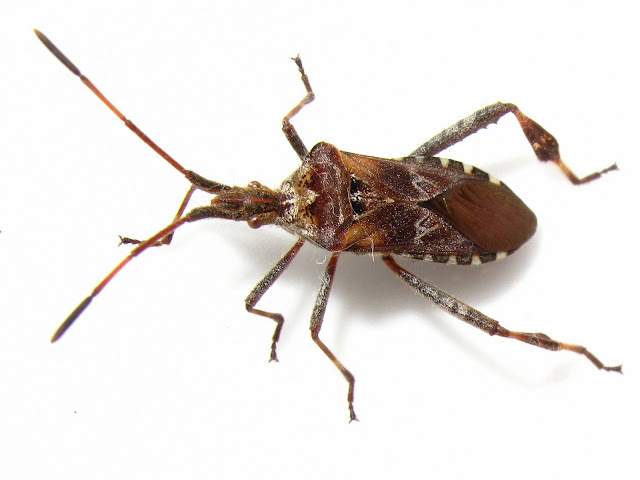
While collecting grapes, I came across a group of adult earwigs. Earwigs are insects of the order Dermaptera, characterised by the presence of a pair of sexually dimorphic appendages at the end of the abdomen called forceps. Female forceps are more or less straight (above), while the male's (below, with two males of different sized forceps) are larger, curved and furnished with a pair of teeth.
F. auricularia males are also dimorphic, with a large forceps form (macrolabic) and a small forceps form (brachylabic).
Earwig forceps are used for defence - they readily raise their forceps when disturbed - and are involved in reproduction, males fight using their forceps as weapond and display them to females during courtship. Males with larger forceps seem to be preferred by females, so they appear to have evolved through sexual selection. Earwigs are also unusual amongst insects in their level of maternal care. Females build a nest chamber, and stay with their eggs after oviposition, they continuously groom their eggs keeping them fee from fungi and sit atop them, occasionally moving them within the nest to areas of optimal temperature and humidity conditions. They also provide their larvae with food and defence for several instars.
In 1998 Thiery Wirth and colleagues, while examining the inheritance of brood number variation in the common European earwig
Forficula auricularia through laboratory crosses, found that single brooded and two-brooded forms did only rarely produce offspring. Further genetic analyses confirmed that
F. auricularia is made of two cryptic species. Cryptic or sibling species are species that cannot be distinguished easily by their morphology, although they are reproductively isolated and might differ in song or pheromones so, despite their similarity to our eyes, males and females do not recognise each other as mates. Cryptic species are very common among many invertebrate groups and are a nightmare for the biologist trying to understand the behaviour or ecology of a species, as it is often impossible to be sure that one is dealing with a single species without using genetic tools. In
F. auricularia, the two cryptic species have not been formally described, but one, referred to as species A, prefers colder climates or higher altitudes, females are single brooded, and tend their clutch for longer and the larvae disperse later; while species B typically lives in more temperate areas, females produces two broods, tends its brood fo r a short time and has an earlier larvae dispersal. In his PhD thesis, Gordon Brown concludes that a single species inhabits the UK, and this is the single brooded species A. At this time of the year, males and females are found above ground and they will be mating. Although males stay with the female and may help with nest building, they are unlikely to make it through the winter and are excluded from the nest once oviposition takes place, while females will overwinter in the nest, where they will lay their eggs early in the year and tend the next generation of earwigs.
References
Guillet, S., Guiller, A., Deunff, J. & Vancassel, M. (2000). Analysis of a contact zone in the Forficula auricularia L. (Dermaptera: Forficulidae) species complex in the Pyrenean Mountains. Heredity, 85 (5), 444-449 DOI: 10.1046/j.1365-2540.2000.00775.x
Thierry Wirth, René Le Guellec, Michel Vancassel & Michel Veuille (1998). Molecular and reproductive characterisation of sibling species in the European earwig (Forficula auricularia) Evolution, 52 (1), 260-265.
Gordon Brown (2007) Sperm competition and male forceps dimorphism in the European earwig
Forficula auricularia (Dermaptera: Forficulina).
PhD Thesis University of St. Andrews.


























